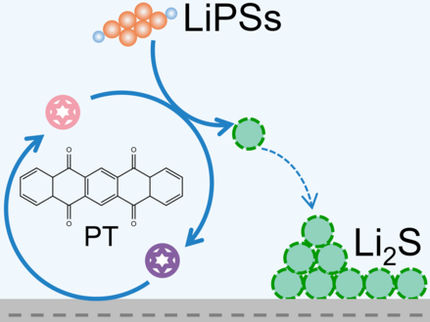Toward making lithium-sulfur batteries a commercial reality for a bigger energy punch
A fevered search for the next great high-energy, rechargeable battery technology is on. Scientists are now reporting they have overcome key obstacles toward making lithium-sulfur (Li-S) batteries, which have the potential to leave today's lithium-ion technology in the dust. Their study appears in the ACS journal Nano Letters.
Xingcheng Xiao, Weidong Zhou, Mei Cai and their colleagues point out that the capabilities of lithium-ion batteries, which power many of our consumer electronics, as well as electric vehicles, have largely plateaued. Scientists have been pursuing a number of new battery technologies to topple today's standard. One heavy focus has been on a key battery component that is currently made out of a metal oxide. Some researchers have been trying to replace the metal oxide with cheaper and lighter sulfur, to make Li-S batteries. In theory, this could allow batteries to pack five to eight times the energy of existing technology. One of the main problems with this approach, however, is that Li-S compounds escape from where they're supposed to be, which causes the battery to lose charge quickly. The team set out to find a way to contain the errant compounds.
To solve this problem, the researchers made tiny, hollow shells out of carbon, which is conductive. They then coated them with a polymer to help confine the Li-S compounds inside. When tested, the structures kept up a high-energy storage capacity (630 mAh/g versus less than 200 mAh/g of lithium-ion batteries) over 600 cycles of fast charging and discharging. "These results provide promising insights and novel concepts for future sulfur-based batteries," the researchers conclude.
Organizations
Other news from the department science

Get the chemical industry in your inbox
By submitting this form you agree that LUMITOS AG will send you the newsletter(s) selected above by email. Your data will not be passed on to third parties. Your data will be stored and processed in accordance with our data protection regulations. LUMITOS may contact you by email for the purpose of advertising or market and opinion surveys. You can revoke your consent at any time without giving reasons to LUMITOS AG, Ernst-Augustin-Str. 2, 12489 Berlin, Germany or by e-mail at revoke@lumitos.com with effect for the future. In addition, each email contains a link to unsubscribe from the corresponding newsletter.
Most read news
More news from our other portals
See the theme worlds for related content
Topic World Battery Technology
The topic world Battery Technology combines relevant knowledge in a unique way. Here you will find everything about suppliers and their products, webinars, white papers, catalogs and brochures.

Topic World Battery Technology
The topic world Battery Technology combines relevant knowledge in a unique way. Here you will find everything about suppliers and their products, webinars, white papers, catalogs and brochures.



























































